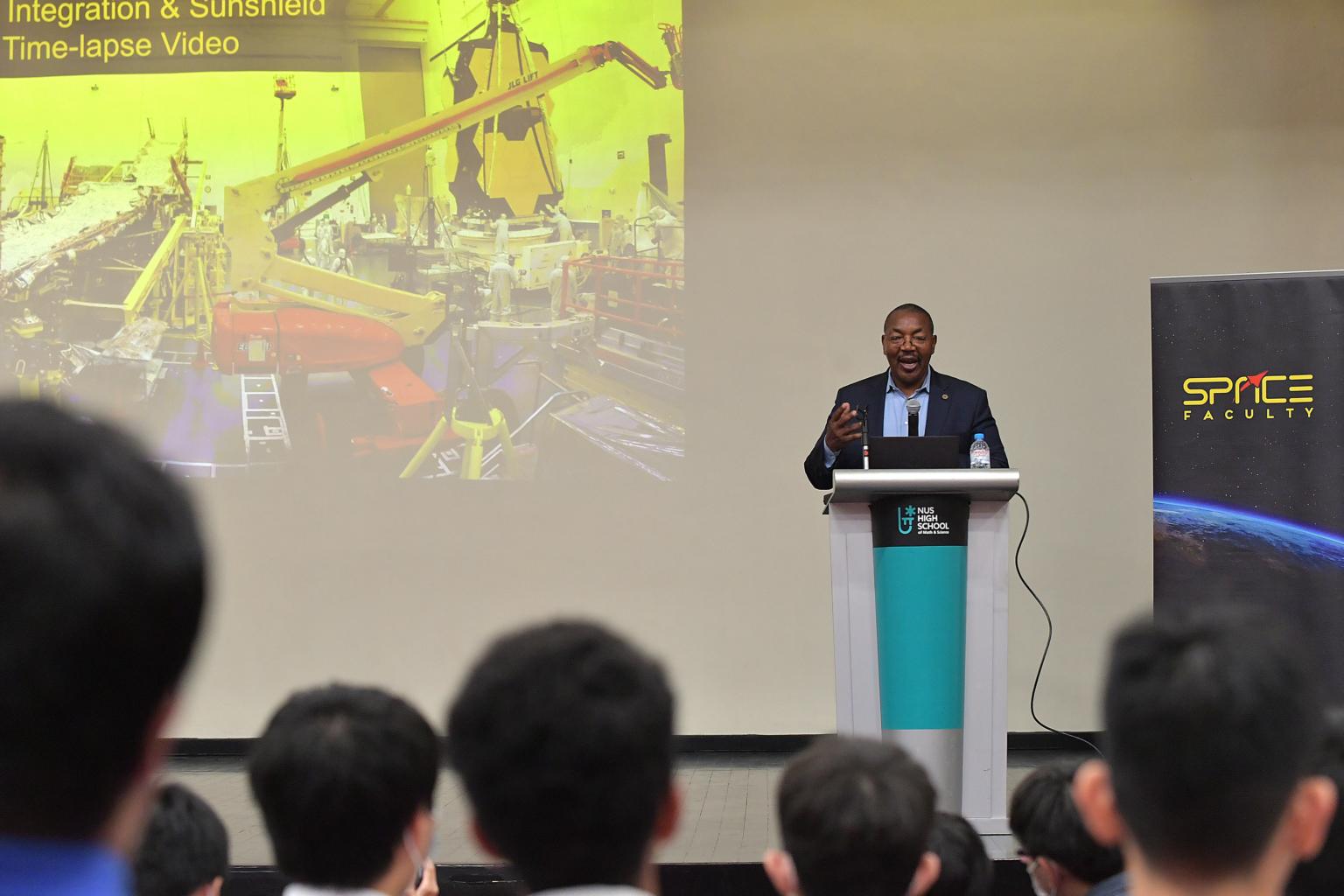Singapore can play a role in future Moon missions: Former James Webb telescope director
Sign up now: Get ST's newsletters delivered to your inbox

Mr Gregory Robinson said some of the intellectual property and research here could be used help out with Artemis activities.
ST PHOTO: ALPHONSUS CHERN
Follow topic:
SINGAPORE - On July 12, the largest and most ground-breaking telescope in orbit released glittering images of faraway galaxies and star nurseries resembling celestial mountain ranges - spectacles that left viewers around the world spellbound.
Beyond the striking pictures, what the former director of the James Webb Space Telescope Programme held near and dear to his heart was a graph chock-full of data points.
The data showed the atmospheric composition of a hazy planet outside the solar system - called exoplanets - which included the clear signature of water. It was detected by the telescope, which has many capabilities.
Water and other things like carbon are important to sustaining life. "So any elements that can make a planet potentially habitable, that's what we're looking for, in exoplanets," Mr Gregory Robinson told students at the NUS High School of Mathematics and Science on Oct 3.
Mr Robinson, 62, who recently retired from his over three-decade-long career at the National Aeronautics and Space Administration (Nasa), was in town to receive the Time100 Impact Award the day before.
The award by Time magazine recognises visionaries who have made an impact and moved their respective industries forward.
Before overseeing the December 2021 launch of the James Webb telescope, Mr Robinson was the deputy associate administrator for programmes at Nasa.
One aim of the roving space observatory is to study the atmospheres of exoplanets, to search for the building blocks of life elsewhere in the universe.
Orbiting the Sun 1.5 million km away from the Earth, Webb will use its powerful infrared lens to peer into the history of the universe, studying the first glows after the Big Bang to the formation of solar systems capable of supporting life on planets.
It can observe the cosmos at greater distances, and thus go further back in time, than its predecessor Hubble or any previous telescope.
Mr Robinson also outlined Nasa's future missions, which include bringing Martian rocks, soil and air to Earth sometime in the 2030s, so that scientists can learn more about the red planet in preparation for a future human mission.
A rover called Perseverance is currently boring holes through rocks and storing away rock samples that will be picked up during the Mars Sample Return mission.
But before mankind touches down on the rocky planet, Nasa wants to take humans back to the Moon, under the Artemis missions starting with an uncrewed test flight into the lunar orbit possibly in November.
Under the Artemis missions, Nasa will land the first woman and the first person of colour on the Moon, and use new technology to explore more of the lunar surface.
The last manned mission to the Moon was in 1972, under the Apollo programme.
And Singapore could play a part in those future missions, said Mr Robinson, who lives in Virginia with his wife and started teaching at Columbia University in 2020.
"We can use some of the intellectual property here, and some of your research to help out with Artemis activities," he told The Straits Times.
The Republic has a budding space ecosystem with more than 50 companies and over 2,000 employees working in the areas of deep tech - which involves quantum technologies and artificial intelligence - and the building of advanced satellite components, among other things.
Since 2011, Singapore has sent 19 satellites - most of them for research purposes - up into space. In July, Singapore's national space office, the Office for Space Technology and Industry, called for research and development proposals on innovative space technologies in domains including connectivity, earth observation and the future of space.
In March, the country became the 18th country to sign the Artemis Accords, the US-led international agreement that sets out guidelines for responsible space exploration.
"Singapore signing the Artemis is a big deal, a big entry into the human spaceflight (scene)," said Mr Robinson.
He encouraged Singapore to collaborate with other space agencies and continue developing niche areas in the global space ecosystem.
"Partnering is a big deal in this business. Even countries that have a lot of wealth do a lot of partnerships. Nasa has over several hundred international partnerships," he noted.
And the Singapore Space and Technology Limited (SSTL), one of Asia's leading space organisations, agrees.
Among many partnerships, SSTL recently inked an agreement with the United Kingdom's Science and Technology Facilities Council to facilitate a two-way flow of investment and trade between Singapore and UK-based space-tech start-ups.
SSTL chief executive Lynette Tan said: "Singapore has a unique role to play as a hub for the space sector with its pool of tech talent, its well-established deep tech industry and the well-connected industry ecosystem that reaches around the globe.
"Our participation in platforms like the Artemis Accords and being part of global trade partnerships are all essential for cementing our position in the global space dialogue."

